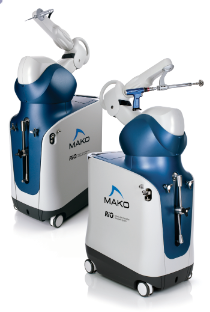By Mark Hansel
NKyTribune Managing Editor
A partial knee replacement surgery that utilizes a robotic arm was performed for the first time in Kentucky at St. Elizabeth Edgewood last month.
Dr. Matthew Hummel of Commonwealth Orthopaedic Physicians performed the Stryker MAKOplasty partial knee resurfacing procedure May 19.
Hummel said benefits of the minimally invasive procedure are expected to include a more natural feeling post-surgery and improved recovery time.
“Stryker MAKOplasty allows us to treat patients with knee osteoarthritis at earlier stages and with greater precision,” Hummel said. “Because it is less invasive and preserves more of the patient’s natural knee, the goal is for patients to have relief from their pain, gain back their knee motion, and return to their daily activities.”
While the procedure has never been performed in the Bluegrass state, Hummel said it has been around for several years. He has been tracking the progress of the procedure and recent results and upgrades in technology convinced him to begin using it on his patients.
“Initially it was considered experimental, but they have made significant progress with both the implant types and just the technology,” Hummel said. “With the improvements, from my point of view, it’s pretty much a no brainer and something that will be incorporated more widely in the future.”
Osteoarthritis is the most common form of arthritis and a leading cause of disability worldwide, according to the American Academy of Orthopaedic Surgeons, so early intervention is critical.
The procedure is performed using RIO, a highly advanced, surgeon-controlled robotic arm system. The device provides the precise, consistent result, surgeons strive for.
The RIO system allows the surgeon to complete a patient specific pre-surgical plan using a CT scan of the patient’s knee. During the procedure, the system creates a three-dimensional, virtual view of the patient’s bone surface and correlates the image to the pre-programmed surgical plan.
Hummel acknowledged that some patients are a bit apprehensive about having a robot perform the procedure, but said it’s not like he’s in another room having a cup of coffee.
“I am actually operating it and doing all the work, but it is helping me apply the best laser lines and guiding techniques,” Hummel said.
As the surgeon uses the robotic arm, its auditory and visual feedback limits the bone preparation to the diseased areas. It also provides for real time adjustments and more optimal implant positioning and placement for each individual patient.
“When it comes down to it, what we are trying to achieve with joints is to re-contour the body to the proper mechanics using metal and polyethylene,” Hummel said. “As much as I template, use diagrams and navigate, the robotic arm gives us that precision that can’t be achieved any other way. We want to do the same exact procedure every time and variation is the enemy of success.”
Hummel admits to a touch of apprehension himself before the first procedure, having never done it on a live patient.
You discuss it with the patient pretty thoroughly and I had done it on sawbones and several cadaver labs,” Hummel said. “Knowing how much research I had put into it, I was pretty comfortable and I had the safety net of knowing I could always change out to the older procedure at any time.”
In addition to a more rapid recovery, the procedure is expected to result in reduced pain, a smaller scar, minimal hospitalization, less implant wear and loosening, and better motion that feels more natural.
“If my implants completely match my plan CT scan, I’m hopeful that with today’s technology, we can have knees that last 25 and 30 years,” Hummel said
Hummel has since performed the procedure on at least one other patients at St. Elizabeth Edgewood.
While it is still very early to assess the results of the procedure on the first patients here, Hummel said the technology is proven now and he is very confident in the long-term results.
“In all honesty, I am very conservative by nature so I waited until there were good results with this,” Hummel said. “Right now it’s used mainly for partial knee replacement, but once it gets expanded to total hips and total knee (full replacements) I think that is where the technological advantages will really come into play.”
The full replacement procedures have not yet gained FDA approval, but Hummel said that is expected in the near future.
Commonwealth Orthopaedic Centers is an independent group that works closely with St. Elizabeth Healthcare to provide services for patients in Northern Kentucky and Greater Cincinnati.


















